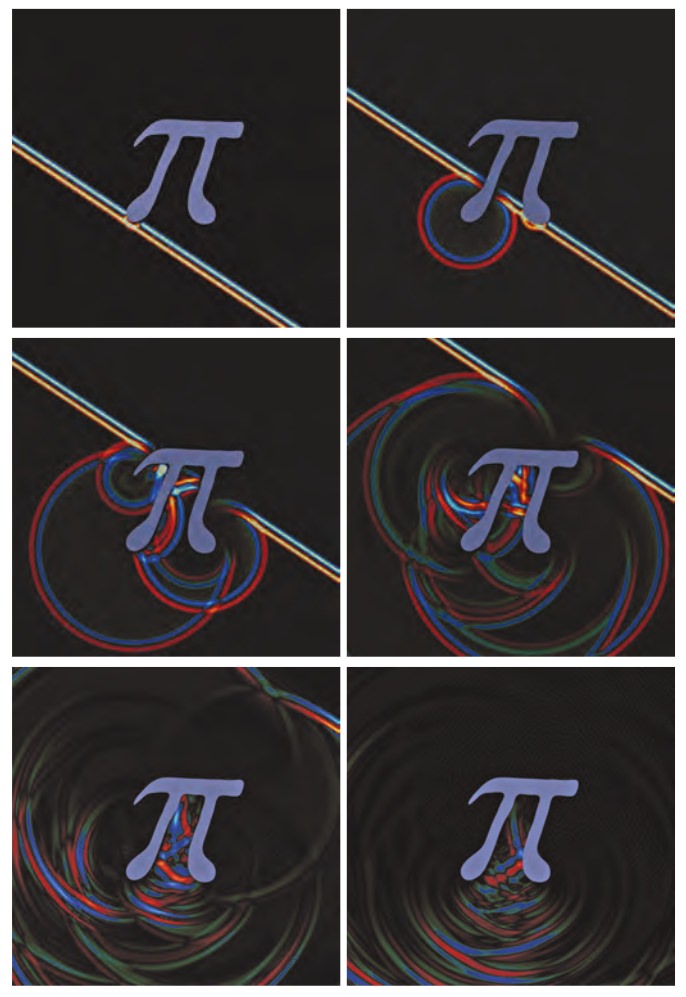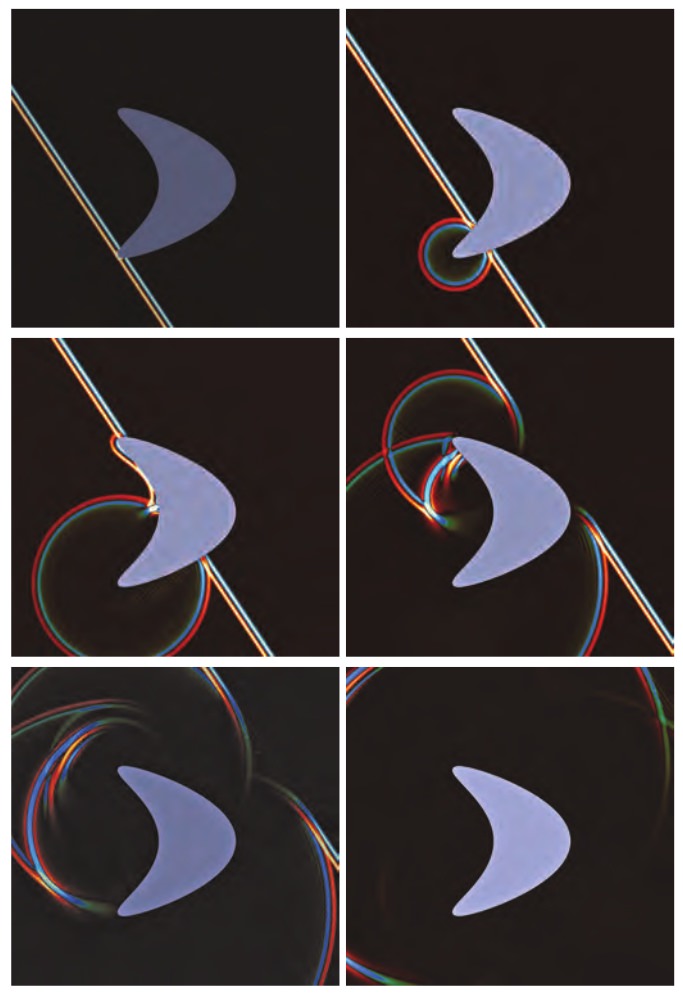by Leslie Greengard and Tonatiuh Sánchez-Vizuet
Cathleen Morawetz was a force at the Courant Institute when one of us (L.G.) arrived as a postdoctoral fellow. It was the last year of her directorship, but she made the time to welcome all newcomers. Her generosity of spirit was unmatched — she encouraged young people in every discipline, and her humour and enthusiasm were infectious.
When she began to study the decay properties of acoustic waves after impinging on an obstacle, essentially no general results were available. To understand the relevant issues, let us begin with the formulation of the problem in terms of the governing linear, scalar wave equation in \( \mathbb{R}^3 \), with a forcing term which is turned on for a finite time: \begin{equation} \label{eleven} u_{tt} (\mathbf{x}, t) = \Delta u(\mathbf{x}, t) + f(\mathbf{x}, t). \end{equation} Here, \( \Delta u \) is the Laplacian operator acting on the scalar function \( u(\mathbf{x}, t) \) and \( f(\mathbf{x}, t) \) is nonzero only in the finite time interval \( 0 \leq t \leq T \). We assume that we have zero initial (Cauchy) data at time \( t = 0 \): \[ u(\mathbf{x}, 0) = 0\quad\text{ and } \quad u_t (\mathbf{x}, 0) = 0. \] We also assume that \( f(\mathbf{x}, t) \) is a smooth, compactly supported and square integrable function in space-time, such as \begin{equation} \label{twelve} f(\mathbf{x},t) = W(\|\mathbf{x} - \mathbf{x}_0\|)\, W\, \biggl(\frac{2t-T}{T}\biggr), \end{equation} where \( \mathbf{x}_0 \in \mathbb{R}^3 \) and \( W(x) \) is a standard \( C^{\infty} \) bump function such as \[ W(x) = \begin{cases} e^{-\frac{1}{1-x^2}} & \text{for } |x| < 1;\\ 0 & \text{otherwise}. \end{cases} \] Then, it is well known that \begin{equation} \label{thirteen} u(\mathbf{x}, t) = \frac{1}{4\pi}\int_{B_{\mathbf{x}_0} (1)} \frac{f (\mathbf{x}^{\prime}, t - \|\mathbf{x} - \mathbf{x}^{\prime}\|)}{\|\mathbf{x}-\mathbf{x}^{\prime}\|}\,d\mathbf{x}^{\prime}, \end{equation} where \( B_{\mathbf{x}_0} (1) \) denotes the unit ball centered at \( \mathbf{x}_0 \). From this formula it is clear that at any point \( \mathbf{x} \) in space, the solution first becomes nonzero at \( t = d_{\min} \) , where \( d_{\min} \) is the distance from \( \mathbf{x} \) to the closest point in \( B_{\mathbf{x}_0} (1) \). It vanishes identically at \( \mathbf{x} \) as soon as \( t > T + d_{\max} \), where \( d_{\max} \) is the distance from \( \mathbf{x} \) to the farthest point \( B_{\mathbf{x}_0} (1) \).

Suppose now that, rather than propagating in free-space, the outgoing spherical wavefront emanating from \( \mathbf{x}_0 \) hits an object as in Figure 3. That is, we assume there is a “sound-soft,” smooth, bounded obstacle \( \Omega \) with boundary \( \partial\Omega \), which is at some distance from \( B_{\mathbf{x}_0} (1) \), so that \[ \Omega \cap B_{\mathbf{x}_0} (1)= \emptyset .\] Then, using the language of scattering theory, the total acoustic field is given by \[ u(\mathbf{x}, t) + u^{\operatorname{scat}} (\mathbf{x}, t) ,\] where the scattered field satisfies the homogeneous wave equation \[ u^{\operatorname{scat}}_{tt} (\mathbf{x}, t) - \Delta u^{\operatorname{scat}} (\mathbf{x}, t) = 0 \] for \( t > 0 \), with initial data \[ u^{\operatorname{scat}} (\mathbf{x}, 0) = 0 \] and \[ u^{\operatorname{scat}}_t (\mathbf{x}, 0) = 0 \] and Dirichlet boundary conditions \[ u^{\operatorname{scat}} (\mathbf{x}, t) = -u(\mathbf{x}, t) \] for \( x \in \partial\Omega \).
Let \( \mathbf{y} \) denote some fixed point away from both the ball \( B_{\mathbf{x}_0} (1) \) and the obstacle \( \Omega \). The question is: can one prove that the scattered field decays at \( \mathbf{y} \), and if so, at what rate? Very little progress had been made on this question until 1959, when Wilcox published a short note showing that in the case of a spherical obstacle, an exact solution could be expressed in terms of spherical harmonics. From this, Wilcox was able to conclude that the solution decays exponentially fast. While an important step, his result yielded no suggestion as to how to proceed in the general case.

In 1961, Morawetz [1] made a critical step forward. She showed that if the reflecting obstacle is star-shaped, then the solution to the wave equation decays like \( t^{1/2} \). A region \( \Omega \) is said to be star-shaped if there exists a point \( \mathbf{p} \in \Omega \), such that for all \( \mathbf{x} \in \Omega \), the line segment from \( \mathbf{p} \) to \( \mathbf{x} \) is contained in \( \Omega \). The object in Figure 3, for example, is not star-shaped, while the object in Figure 4 is. It is perhaps surprising that for non-star-shaped obstacles, very little is understood to the present day.
The qualitative difference in the behavior of waves reflecting from obstacles that are not star-shaped and those that are is illustrated in Figures 3 and 4. In the first three panels of each figure, as the incoming wave hits the object, the scattered wave is clearly visible, with energy propagating outwards in all directions. In the next three panels, more of the energy is carried away. In Figure 3, some of the energy remains behind for quite some time, and in the last panel a significant amount of energy has focused in a small neighborhood. In Figure 4, the energy has propagated outward without significant concentration and appears to decay much more rapidly.

Morawetz’s writing style was very much that of a storyteller. To get a sense of that, here is the beginning of the proof of the main theorem in her 1961 paper [1]:
The proof is based on energy identities, i.e., quadratic integral relations satisfied by all solutions. This is one of the most powerful tools for getting estimates for solutions of elliptic, hyperbolic or mixed equations. The most familiar identity of this kind for the wave equation is obtained by multiplying \( u_{tt} = \Delta u \) by \( u_t \) and integrating in the slab \( 0 \leq t \leq t_1 \); the resulting integral identity satisfies the conservation of energy. Here we use another multiplier in the place of \( u_t \) introduced by Protter for another purpose. The significance of using alternative multipliers has been frequently emphasized by Friedrichs and is often referred to as Friedrichs’s \( a \), \( b \), \( c \)-method. The multiplier here is \begin{equation} \label{fourteen} xu_x + yu_y + zu_z + tu_t + u \end{equation} and from the resulting identity we conclude that all the energy is carried outward.
In truth, Morawetz was being overly modest. It was her keen insight that allowed for the selection of a multiplier which would yield the desired result. The power and generality of this approach led to breakthroughs in many wave propagation problems, with the state of the art collected in Morawetz’s 1966 monograph “Energy identities for the wave equation,” originally released as a Courant Institute technical report.
A second major step forward in understanding the decay of waves scattered from star-shaped obstacles came in 1963, in joint work with Lax and Phillips. They showed that, in fact, such solutions decay exponentially (as they do for a sphere), not just as \( t^{-1/2} \). The proof relies on an observation of Lax and Phillips that there is a function \( Z(t) \) which satisfies the semigroup property \begin{equation} \label{fifteen} Z(t + s) = Z(t)Z(s), \end{equation} and whose norm controls the decay of the solution. In this context, Morawetz’s 1961 paper shows that for some time \( t = \tau \), \( |Z(\tau)| \) has decayed to less than one: \[ |Z(\tau)| < 1 = e^{-\alpha}\quad\text{ for some } \alpha > 0. \] That is enough to guarantee exponential decay! One simply writes \[ t = n\tau + t_1\quad\text{ where }t_1 < \tau, \] from which \[ |Z(t)| = |Z(t_1 )|\,|[Z(\tau)]^n | \leq |Z(t_1 )|e^{-\alpha n} = Ce^{-\alpha t/\tau}. \]
Nontrapping objects

This situation was studied by Morawetz, Ralston, and Strauss in their 1977 article, where they proved a remarkable extension of Morawetz’s earlier results; if the object \( \Omega \) does not trap rays, then the scattered wave decays exponentially. The proof involves the introduction of an escape function (a generalization of the geometric intuition of an “escape path of finite length”) and a different multiplier from that in Morawetz’s 1961 paper. The use of such Morawetz multipliers is now ubiquitous in the analysis of PDEs.
Denoting by \( S \) a sphere which contains the smooth scatterer \( \Omega \), considering \( \mathbf{x} \in S\backslash \Omega \), and letting \( \xi \) be a unit vector in \( \mathbb{R}^3 \), \( p(\mathbf{x}, \xi) \) is said to be an escape function if it is real-valued, \( C^{\infty} \), and, informally speaking, “strictly increasing along rays, \( \xi \) being the ray direction at \( \mathbf{x} \).” Rays are said to be not trapped if the total path length in \( S\backslash \Omega \) is bounded and waves are said to be not trapped if the local energy in \( S\backslash \Omega \) decays to zero uniformly. Without entering into details, Morawetz, Ralston, and Strauss showed (1) that if rays are not trapped, then there exists an escape function and (2) that if there exists an escape function, then waves are not trapped, from which the result follows.
Geometric optics and frequency domain analysis
In the study of linear wave propagation, much of our understanding comes from the frequency domain — that is, analyzing the Fourier transform of the wave equation \eqref{eleven}: \begin{equation} \label{sixteen} - k^2 U(\mathbf{x}, k) - \Delta U(\mathbf{x}, k) = F(\mathbf{x}, k). \end{equation} Depending on the context, this is referred to as the Helmholtz or reduced wave equation. In 1968, Morawetz, together with Don Ludwig, began an investigation of exterior scattering from star-shaped surfaces in the frequency domain [2]. Two major results were presented there. First, they provided a key proof of the well-posedness of the scattering problem for sound-soft boundaries (homogeneous Dirichlet boundary conditions) with respect to the boundary data and forcing term \( F(\mathbf{x}, k) \) in \eqref{sixteen}. They also introduced what are now called Morawetz identities for the Helmholtz equation. Second, they showed that the formulas produced by the theory of geometrical optics are asymptotic to the exact solution. The relevant asymptotic regimes are illustrated in Figure 6.

Without entering into technical details, geometrical optics is based on expanding the incoming and scattered waves in terms of a series in inverse powers of the wavenumber \( k \) about the point \( \mathbf{x}_0 \) (see Figure 6). Ludwig had earlier proposed an expansion for the penumbra region as well. Morawetz and Ludwig showed that all of these expansions are truly asymptotic: to the solution in the illuminated region and penumbra, and asymptotically zero in the deep shadow.
Although Morawetz herself did little numerical computation, her analytic work (especially on multipliers) has played a major role in the design of numerical methods. We cannot do justice to the literature here, but refer the reader to three recent papers: one on eigenvalue computation, one on frequency domain scattering, and one on time-domain integral equations [e1] [e2] [e5]. We have only been able to scratch the surface of her legacy in this note. Her contributions are profound and deep, and have changed the way we think about partial differential equations. She was a wonderful friend and colleague and is greatly missed.